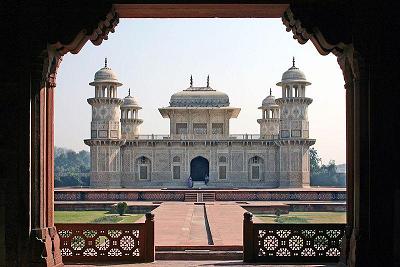|
 |
|
Welcome |
|
Rajasthan
Tours |
|
|
|
|
|
|
|
|
|
|
|
|
|
|
|
|
|
|
|
|
|
|
|
|
|
|
|
|
|
|
|
|
|
|
Introduction of
Itmad-Ud-Daulah's Tomb |
|
Itmad-ud-Daula's Tomb is a Mughal mausoleum in the city of Agra in the
Indian state of Uttar Pradesh. Often described as 'jewel box,
sometimes called the 'Baby Taj', the tomb of I'timad-ud-Daulah is
often regarded as a draft of the Taj Mahal.
Along with the main building, the structure consists of numerous
outbuildings and gardens. The tomb, built between 1622 and 1628
represents a transition between the first phase of monumental Mughal
architecture - primarily built from red sandstone with marble
decorations, as in Humayun's Tomb in Delhi and Akbar's tomb in
Sikandra - to its second phase, based on white marble and pietra dura
inlay, most elegantly realized in the Taj Mahal.
The mausoleum was commissioned by Nur Jahan, the wife of Jahangir, for
her father Mirza Ghiyas Beg, who had been given the |

Itmad Ud Daulah's Tomb |
title of I'timad-ud-Daulah (pillar of the state). Mirza Ghiyas Beg was also the
grandfather of Mumtaz Mahal (originally named Arjumand Bano, daughter
of Asaf Khan), the wife of the emperor Shah Jahan, responsible for the
building of the Taj Mahal.
|
|
Itmad-Ud-Daulah's Tomb |
|
Located on the left bank of the Yamuna
river, the mausoleum is set in a large cruciform garden criss-crossed
by water courses and walkways. The mausoleum itself covers about
twenty-three square meters, and is built on a base about fifty meters
square and about one meter high. On each corner are hexagonal towers,
about thirteen meters tall.
The walls are white marble from Rajasthan encrusted with semi-precious
stone decorations - cornelian, jasper, lapis lazuli, onyx, and topaz
formed into images of cypress trees and wine bottles, or more
elaborate decorations like cut fruit or vases containing bouquets.
Light penetrates to the interior through delicate jālī screens of
intricately carved white marble.
Many of Nūr Jahan's relatives are interred in the mausoleum. The only
asymmetrical element of the entire complex is that the cenotaphs of
her father and mother have been set side-by-side, a formation
replicated in the Taj Mahal |
|
|
 |
 |
|
Itmad Ud Daulah's Tomb |
Itmad Ud Daulah's Tomb |
 |
 |
|
Interior Gate |
Exterior Gate |
 |
 |
|
Cupola of minaret
|
Detail of one of the walls |
|
|
|
|
|
|
|
|